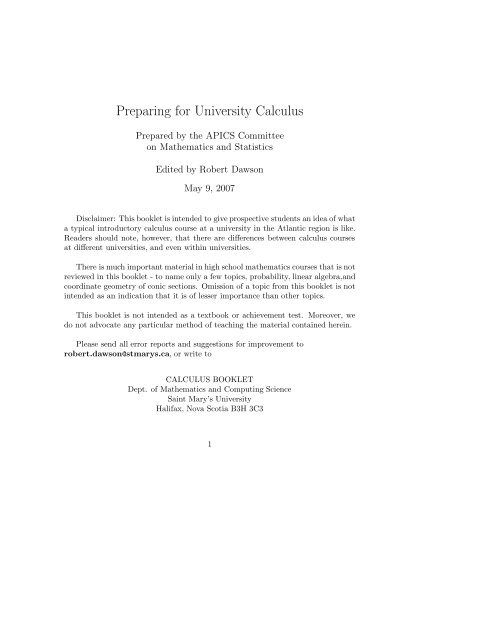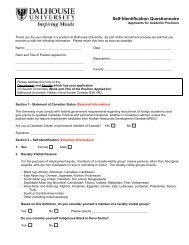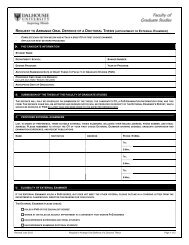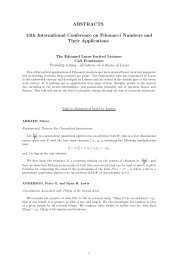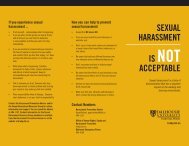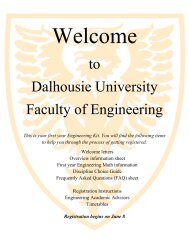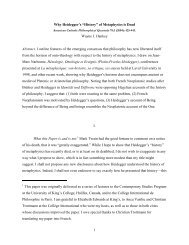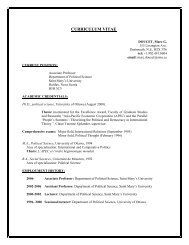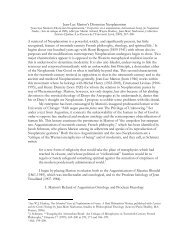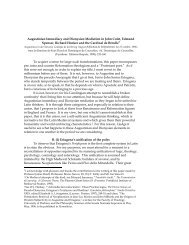Preparing for University Calculus - Math and Computer Science
Preparing for University Calculus - Math and Computer Science
Preparing for University Calculus - Math and Computer Science
Create successful ePaper yourself
Turn your PDF publications into a flip-book with our unique Google optimized e-Paper software.
<strong>Preparing</strong> <strong>for</strong> <strong>University</strong> <strong>Calculus</strong>Prepared by the APICS Committeeon <strong>Math</strong>ematics <strong>and</strong> StatisticsEdited by Robert DawsonMay 9, 2007Disclaimer: This booklet is intended to give prospective students an idea of whata typical introductory calculus course at a university in the Atlantic region is like.Readers should note, however, that there are differences between calculus coursesat different universities, <strong>and</strong> even within universities.There is much important material in high school mathematics courses that is notreviewed in this booklet - to name only a few topics, probability, linear algebra,<strong>and</strong>coordinate geometry of conic sections. Omission of a topic from this booklet is notintended as an indication that it is of lesser importance than other topics.This booklet is not intended as a textbook or achievement test. Moreover, wedo not advocate any particular method of teaching the material contained herein.Please send all error reports <strong>and</strong> suggestions <strong>for</strong> improvement torobert.dawson@stmarys.ca, or write toCALCULUS BOOKLETDept. of <strong>Math</strong>ematics <strong>and</strong> Computing <strong>Science</strong>Saint Mary’s <strong>University</strong>Halifax, Nova Scotia B3H 3C31
c○2002 by the Atlantic Provinces Council on the <strong>Science</strong>s <strong>Math</strong>ematics <strong>and</strong>Statistics CommitteeThis booklet may be freely reprinted <strong>for</strong> educational <strong>and</strong> private use. For detailssee page 9.2
1 About First-Year <strong>Calculus</strong>1.1 What math will I need in university?The answer to this depends on what you are taking, <strong>and</strong> you should check withthe university or universities that you are thinking of attending. As a generalrule, however, if you are planning to get a degree in science, you will probablyneed one or more courses in calculus (some universities permit programming orstatistics instead in some cases). If you are taking courses in the social sciences orlife sciences, you will probably need one or more courses in statistics; <strong>and</strong> degreesin physics, engineering, astronomy, mathematics, or computing science (<strong>and</strong> someother subjects) will require additional mathematics courses beyond the first yearlevel.Some departments (other than mathematics) may teach their own courses incalculus, linear algebra, or statistics. In this case, you may not need to take thest<strong>and</strong>ard first-year courses offered by the mathematics department.1.2 What is calculus?<strong>Calculus</strong> is a branch of mathematics that deals with rates of change. Its roots goback as far as Ancient Greece <strong>and</strong> China, but calculus as we know it today beganwith Newton <strong>and</strong> Leibnitz in the 17th century. Today it is used extensively in manyareas of science.Basic ideas of calculus include the idea of limit, derivative, <strong>and</strong> integral. Thederivative of a function is its instantaneous rate of change, with respect to somethingelse. Thus, the derivative of height (with respect to position) is slope; thederivative of position (with respect to time) is velocity; <strong>and</strong> the derivative ofvelocity (with respect to time) is acceleration.The integral of a function can be thought of as the area under its graph, oras a sort of total over time. Thus, the integral of slope is (up to a constant)height; the integral of velocity is, up to a constant, position; <strong>and</strong> the integralof acceleration (with respect to time) is velocity. As you may have guessed,integrals <strong>and</strong> derivatives are related, <strong>and</strong> are in a sense opposites.Now, many functions (though not all) can be represented by algebraic expressions.For instance, the area of a circle is related to its radius by the <strong>for</strong>mulaA = πr 2 ; <strong>and</strong> the distance that a body falls in a time t, starting at rest, is given3
y x =1/2at 2 . Given such an expression, calculus allows us to find expressions <strong>for</strong>the integral <strong>and</strong> derivative of the function, when they exist.1.3 Why is calculus important?In the sciences, many processes involving change, or related variables, are studied.If these variables are linked in a way that involves chance, <strong>and</strong> significant r<strong>and</strong>omvariation, statistics is one of the main tools used to study the connections. But, incases where a deterministic model is at least a good approximation, calculus is apowerful tool to study the ways in which the variables interact. Situations involvingrates of change over time, or rates of change from place to place, are particularlyimportant examples.Physics, astronomy, mathematics, <strong>and</strong> engineering make particularly heavy useof calculus; it is difficult to see how any of those disciplines could exist in anythinglike its modern <strong>for</strong>m without calculus. However, biology, chemistry, economics,computing science, <strong>and</strong> other sciences use calculus too. Many faculties of sciencethere<strong>for</strong>e require a calculus course from all their students; in other cases you maybe able to choose between, say, calculus, statistics, <strong>and</strong> computer programming.It should be understood that there is more to mathematics than calculus. Linearalgebra, probability, geometry, <strong>and</strong> combinatorics are just some of the otherbranches of mathematics, introduced in schools, that are important at the unversitylevel. And problem-solving skills, which cut across all branches of mathematics,allow the mathematics to be applied to other subjects.1.4 What background do I need?You should have taken Grade 12 precalculus mathematics, or an equivalent course,<strong>and</strong> understood the material. The second part of this booklet gives some examplesof the sort of thing that you should be able to do.You do not need a high school calculus course; if you have taken one, you shouldnot assume that you can skip classes, or not study, during the first part of thecourse. <strong>University</strong> calculus goes deeper than most courses in high schools do, evenif they appear to cover the same material. If you have been lucky enough to havea calculus course in high school, consider it as a preview of the upcoming featurethat you are now about to see! And remember to keep using your algebra <strong>and</strong> othermathematical skills, to keep them sharp.4
1.5 What is taking university calculus like?You will probably find that university calculus is faster-paced than your high-schoolcourses. At most universities the lecture sections will be bigger — possibly over ahundred students — <strong>and</strong> the professor will not be able to slow the class to the paceof the slowest students. You — <strong>and</strong> you alone — will be responsible <strong>for</strong> h<strong>and</strong>ingwork in on time, <strong>and</strong> <strong>for</strong> being present <strong>for</strong> classes, tests, <strong>and</strong> exams.This is not a course that can be passed by just memorizing everything; you haveto underst<strong>and</strong> it. This won’t happen instantly, <strong>and</strong> the instructor cannot make ithappen; you have to do that yourself, <strong>and</strong> be an active participant in the course. Ifyou make this ef<strong>for</strong>t consistently through the term, you will find that it pays off.The course material consists of a rather small number of big ideas, <strong>and</strong> a moderatenumber of <strong>for</strong>mulae you will need to know, not hundreds of short cuts <strong>and</strong>special rules. A common mistake, especially with word problems, is trying to learnone “plug-in” rule <strong>for</strong> each different kind of problem that you might encounter.Don’t do that; instead, try to underst<strong>and</strong> the underlying patterns.Here are the stages by which you will learn <strong>and</strong> master a new idea in calculus.• First, you should read ahead in the textbook, so that you have at least arough idea of what the instructor is going to say. This will help you followthe lecture <strong>and</strong> make note-taking easier.• In the lecture, the instructor will introduce the new idea, give someexamples, <strong>and</strong> perhaps explain how it fits in with other ideas or give someproblem-solving tips.• At this point, a few students think the process is over till the final exam <strong>and</strong>that if they don’t know everything then, it will be the instructor’s fault. Notso; the ball is back in your court! Work on problems, do the assignments(including additional study problems if you need to, whether assigned or not),<strong>and</strong> make sure that you underst<strong>and</strong> what you are doing. It’s better to work<strong>for</strong> an hour or so several times a week than in one killer session. This isthe heart of the learning process; the lecture is just to help you getstarted.• If you don’t underst<strong>and</strong> something, decide what it is that you don’t underst<strong>and</strong><strong>and</strong> go <strong>for</strong> help. Go prepared to tell the instructor (or friend, tutor, learning5
center person, etc.) what it is that you don’t underst<strong>and</strong>. (“Everything” is nothelpful.) On the other h<strong>and</strong>, do not go along dem<strong>and</strong>ing that the instructortell you how to answer Question 6.11 <strong>and</strong> refusing to listen to any explanationof why it’s done that way.• Finally, your knowledge will be tested on quizzes, midterms, or finalexaminations. The exams will probably make up the majority of your grade.If you have h<strong>and</strong>ed in copied, half-understood assignments, you will lose moremarks at exam time than you gained in the short term. But if you keptup with the lectures <strong>and</strong> assignments, making sure you understood each bitbe<strong>for</strong>e going on, you will probably do well.If you find yourself falling behind, you will have to catch up. Don’t panic -catching up is not impossible. There are various resources to help.• Yourself. If you are falling behind <strong>and</strong> not putting plenty of time in studying- say five or six hours outside class per week <strong>for</strong> each course - the solutionmay be as near as your desk <strong>and</strong> textbook.• Your textbook contains hundreds of worked examples, <strong>and</strong> thous<strong>and</strong>s ofproblems. Usually, about half of the problems have answers in the back of thebook; <strong>and</strong> you may be able to buy a study guide that shows the working ofthose problems in more detail. You can also get other books such as “Schaum’sOutline of <strong>Calculus</strong>” containing more worked problems.• Your instructor will have office hours during which you can go <strong>for</strong> help. Tryto figure out ahead of time what you need help with; you will get more out ofthe visit.• Discuss your problem with your classmates. This is not the same thing ascopying their assignments, of course! <strong>University</strong> penalties <strong>for</strong> cheating aresevere, <strong>and</strong> can include expulsion.• You might want to hire a tutor. Do not try to get the tutor to do yourassignments <strong>for</strong> you; you will not be able to bring the tutor into the examwith you! Get the tutor to make sure you underst<strong>and</strong> the material.• Your university may have a math learning center, group tutoring sessions,or other resources that you can use. Take advantage of them!6
• Your university or student union may well have workshops on effective studying,effective note-taking, exam nerves, etc. There will also be counsellingavailable <strong>for</strong> other problems that might interfere with your study.1.6 HELP! I have to write a placement test!Many Atlantic-area universities have found that incoming students are not uni<strong>for</strong>mlywell-prepared <strong>for</strong> calculus. Many students are very well prepared, <strong>and</strong> readyto start the usual calculus curriculum; but some are not. As a result, placementtests are common, <strong>and</strong> at some universities, if you do not pass the placement test,you will be required to take a remedial course covering important material fromthe high school curriculum be<strong>for</strong>e you can take calculus. At other universitiesyou may just be advised to take the remedial course, or allowed into a slow-movingsection that takes two semesters to cover the first semester’s material.This is to stop students from starting calculus without adequate preparation<strong>and</strong> then falling behind <strong>and</strong> failing. Experience has shown that most students whostart calculus without adequate preparation do fail.The test is often multiple-choice so that it can be graded as quickly as possible. Itwill generally be closed-book <strong>and</strong> written without a calculator (see the next section).Because success in first-year calculus requires a fairly high level of preparation, <strong>and</strong>because the test covers some very elementary (but important) material, the passmark may be higher than 50%. You will probably have to write the test at or be<strong>for</strong>ethe beginning of term; find out ahead of time what the rules are at the universityyou plan to attend.Some sample questions <strong>for</strong> one such placement test may be found athttp://conway.math.unb.ca/Placement/. Some harder questions, to help yousee if you’re really ready, are athttp://www.math.unb.ca/ready/exercise.html.1.7 HELP! They want to take my calculator away!In some first-year calculus courses, calculators are not permitted. To be exact, theydo not permit them in the pretest, tests, or exams; you can certainly have one in thelecture if you want, or use one <strong>for</strong> your homework. In other introductory calculuscourses, calculators or computers are used intensively to explore the behaviour offunctions. You should find out the policy at the university you plan to attend!7
• If your calculus course has a no-calculator policy, the questions will be designedso that a calculator is not needed. It would be unreasonable <strong>for</strong> theprofessor to ask you to compute (1.42433x +2.4577) 3 without a calculator.But (s)he won’t. You might be asked to compute (x +2) 3 ; the calculator willnot be needed here.• In a situation where calculators are not permitted, any expression that doesnot have a well-known simplification may always be left as it is. Thus, <strong>for</strong>instance, while you are expected to know that √ 25 = 5, <strong>and</strong> that log 10 1000 =3, you may always leave (eg) √ 17 or ln(1000) in those <strong>for</strong>ms. Now, that is eveneasier than using the calculator! Do note, however, that you would generallybe expected to simplify (eg) √ 17/ √ 17 to 1, should such an expression arise!The use of algebra (as opposed to arithmetic) to simplify expressions will becommon in your course. Conventions as to what should <strong>and</strong> should not besimplified will be made clear during the course.• Even if your calculus course does allow calculators, you will often be requiredto give, as an answer, an algebraic expression involving integers. For instance,you might be asked: “Give the answer as an expression of the <strong>for</strong>m √ b/c whereb <strong>and</strong> c are integers.” It is far more important, <strong>for</strong> the purposes of calculus, toknow that sin(π/4) = √ 2/2, <strong>and</strong> why, than to know that it is approximatelyequal to 0.707.When you get into courses where there is a reason <strong>for</strong> test questions to involvesignificant amounts of arithmetic, you will be allowed — <strong>and</strong> encouraged — to usea calculator, perhaps even a computer. In the meantime, if you are not allowedto use a calculator in tests, you can be fairly sure that the arithmetic will be keptsimple.1.8 More In<strong>for</strong>mationYou can get further in<strong>for</strong>mation about requirements <strong>and</strong> regulations at specificuniversities from their admissions offices, calendars, <strong>and</strong> Web sites.8
2 Ordering in<strong>for</strong>mationGetting a copy freePlease note, this is the truly cool way to get this booklet (<strong>and</strong> saves us time).• This document may be downloaded in Adobe PDF or PostScript <strong>for</strong>mat fromthe Web, at our websitehttp://cs.smu.ca/apics/calculus/welcome.php.This site also contains links to free software that will allow you to display <strong>and</strong>print the document.• Individuals are hereby granted permission to make photocopies of this document<strong>for</strong> their personal use at no charge, provided they include the entire textincluding the cover, title page, <strong>and</strong> this page. Please verify that the editionyou copy is not out of date.If all else fails, send money• Booklets can be purchased in small quantities (1 to 4) at $2 each fromCALCULUS BOOKLETc/o Department of <strong>Math</strong>ematics <strong>and</strong> Computing <strong>Science</strong>Saint Mary’s <strong>University</strong>Halifax, Nova ScotiaB3H 3C3Please send cheque or money order made out to “Department of <strong>Math</strong>ematics<strong>and</strong> Computing <strong>Science</strong>, Saint Mary’s <strong>University</strong>”. We cannot process creditcards or ship COD.• Booklets can be purchased in bulk from the same address <strong>for</strong> $10 <strong>for</strong> 10booklets. Please email rdawson@husky1.stmarys.ca <strong>for</strong> pricing on ordersover 500.9
3 The <strong>Math</strong> You’ll NeedIn this section, we present over 175 questions that cover the absolute minimumof mathematical skills that you will need <strong>for</strong> university calculus. We give workedanswers <strong>for</strong> a few; the answers to the rest are in the back of the booklet.There are important topics in high school mathematics that are not covered here,<strong>and</strong> there may even be some things you’ll need <strong>for</strong> calculus that we have missed.A good student should be able to answer significantly more challenging problemsthan these. However, if you underst<strong>and</strong> all of this material, you will be reasonablywell prepared <strong>for</strong> calculus.3.1 ArithmeticYou should be able to do basic arithmetic without a calculator, including operationson fractions, negative numbers, <strong>and</strong> decimals. You should be able to computesimple powers <strong>and</strong> roots. This material, which is from the elementary <strong>and</strong> juniorhigh school curriculum, is fundamental <strong>for</strong> everything that follows. Also, manyarithmetic problems are really “algebra with numbers”.Examples:1. Find 1 3 + 2 5 .Solution: To add (or subtract) fractions, you must first find a commondenominator:13 + 2 5 = 1 · 53 · 5 + 2 · 35 · 3 = 5 15 + 6 15 = 11152. Convert 1.25 to a fraction in lowest terms. Solution: To convert a decimalto a fraction, write as a fraction over a power of 10, then reduce.1.25 = 125100 = 5 · 254 · 25 = 5 4(HINT: Memorizing some common equivalences between decimals <strong>and</strong> fractions,such as 1/2 =0.5, 1/3 =0.333 ..., etc., could save you some timehere!)10
Problems: (answers on page 40)1. Find 2 3 + 3 52. Find 3 4 − 1 53. Find 1 3 × 6 5in lowest terms.4. Convert 3.125 to a fraction in lowest terms.5. Convert 37/25 to a decimal.6. Convert 17/10 to a decimal.7. Find 0.0001 × 0.01/0.0018. Find 1.23 × 0.19. Find 1.005 + 9.99510. Find 1 − (−2)11. Find √ 6412. Find 20 3 /20 5 as a decimal.11
3.2 Basic AlgebraAs observed above, basic algebra is closely related to arithmetic, <strong>and</strong> many of itsrules are familiar as “rules of arithmetic”. You should be aware that a × b may bewritten as ab.You should know the basic rules <strong>for</strong> addition, subtraction, multiplication, division,<strong>and</strong> exponents, <strong>and</strong> be aware of the operations such as division by 0 <strong>and</strong>taking the square root of a negative number that cannot be done within the realnumber system.You should know how to solve a simple equation, simplify an algebraic expression,<strong>and</strong> evaluate an expression by plugging values into it. All of these will be veryimportant when you take calculus.Examples:1. Simplify a7 b 3a 4 b 4 .Solution: By basic rules of exponentsa 7 b 3a 4 b 4 = a7−4 b 3−4 = a 3 b −1 = a3b2. Solve ax +4=2x − a <strong>for</strong> x when a =5.Solution: Substituting a = 5 <strong>and</strong> adding, subtracting <strong>and</strong> dividing likequantities on both sides of the equation we reduce to an equation which is itsown solution:so x = −3.5x +4 = 2x − 55x +4− 2x = 2x − 5 − 2x3x +4− 4 = −5 − 4( ( 1 13x = −93)3)x = −312
Problems: (answers on page 40)1. Simplify (a 4 /a 2 ) 22. Simplify abc − acb + acd − ace, factoring if possible .yx3. Simplify+ x .2x4. Simplify (a 2 + a 3 + a 4 )/a, factoring if possible.5. Solve 3x +2=x + 2 <strong>for</strong> x.6. If x = 5 <strong>and</strong> y = 7, find x 2 − xy +3y.7. Simplify a2 − (−a 2 )a 28. If a = 5 <strong>and</strong> b = 2, find a − b 2 +2ab9. Solve x 5 +2x +3=x 5 − x.10. If x = 3 <strong>and</strong> xy = 1, find y.11. Simplify (a 2 /a −2 )(b −2 /b 2 ).12. Solve a + x +2=a − x +4.13
3.3 Inequalities <strong>and</strong> absolute valuesYou should be able to solve simple inequalities <strong>and</strong> per<strong>for</strong>m algebraic operationswith them. In particular, you should know which operations reverse inequalities<strong>and</strong> which ones preserve them. You should underst<strong>and</strong> interval notation, includingopen, closed, <strong>and</strong> half-open intervals, <strong>and</strong> intervals with limits at ∞. You shouldknow how to compute an absolute value, <strong>and</strong> to do simple algebra using the absolutevalue function.Examples:1. Solve 7 − 2x ≤ 4.3Solution: 7 − 2x ≤ 4 implies 7 − 2x ≤ 12 <strong>and</strong> −2x ≤ 5.3Thus x ≥− 5 2 ,orx ∈ [− 5 2 , ∞).2. Solve x 2 +3x − 10 ≤ 0.Solution:Factoring the left side, (x + 5)(x − 2) ≤ 0. The corresponding equation(x + 5)(x − 2) = 0 has solutions −5 <strong>and</strong> 2 which divide the real line into threeintervals: (−∞, −5), (−5, 2), (2, ∞).On each of these intervals we determine the sign of the factors as follows:Interval x +5 x − 2 (x + 5)(x − 2)(−∞, −5) − − +(−5, 2) + − −(2, ∞) + + +From the table we find that x 2 +3x − 10 ≤ 0 on the interval x ∈ [−5, 2].3. Solve |4x +5| > 9.Solution: |4x +5| > 9 is equivalent to4x +5> 9 or 4x +5< −94x >4 or 4x1 or x
Problems: (answers on page 40)1. If y>x, x ≥ w, <strong>and</strong> ww, (b) yz, (d) yb, can we conclude that:(a) a 2 >b 2 always; (b) a 2 >balways; (c) a 2 >b 2 if b>0;(d) a 2 ≥ b 2 always; (e) none of these are true.4. For what values of x is 1/(1 + x) > −1?5. For what values of y is y 2 > 0?6. For what values of y is y 2 ≥ 2?7. For what values of x is |x − 3| ≤1?8. Which of the following intervals contains the point 0?(a)(−∞, 0) (b)(−1, 1) (c)(0, ∞)(d)all of a,b,c (e) a <strong>and</strong> c only9. Which of the following intervals contains the point 0?(a)(−∞, 0] (b)[−1, 1] (c)[0, ∞)(d)all of a,b,c (e) a <strong>and</strong> c only10. Find |3 −|3 − 6||11. Simplify x 2 − 2|x 2 |.12. Solve −1 < 2x − 5 < 7.13. Solve x 2 − 3x +2> 0.14. Solve |2x − 3| ≤5.15. Solve the equation |x+3||2x+1| =1. 15
3.4 FunctionsYou should underst<strong>and</strong> the concept of “function” <strong>and</strong> “inverse function” <strong>and</strong> knowhow to compute the composition of two or more functions. You should be able todetermine the range <strong>and</strong> domain of a simple function. This will be important <strong>for</strong>underst<strong>and</strong>ing the Chain Rule, various methods of integration, <strong>and</strong> limits.Examples:1. Find the domain of the functions defined by:(a) f(x) = 1x 2 −1(b) g(x) = √ 4 − xSolution(a) The domain of f(x) = 1x 2 −1 is the set of all values of x such that x2 −1 ≠0;that is x ≠ ±1 orx ∈{(−∞, −1) ∪ (−1, 1) ∪ (1, ∞)}(b) The domain of g(x) = √ 4 − x is the set of all values of x such that4 − x ≥ 0; that is x ≤ 4orx ∈ (−∞, 4].2. If f(x) =3x + 5, findSolutionf(x + h) − f(x)hf(x + h) − f(x)h== 3h h[3(x + h)+5]− [3x +5]h= 3=3x +3h +5− 3x − 5h3. If f(x) = √ x − 1 <strong>and</strong> g(x) =x 2 , find:(a) f(g(x)) (b) g(f(x))Solution(a) f(g(x)) = f(x 2 )= √ x 2 − 1; this has domain (−∞, −1] ∪ [1, ∞).(b) g(f(x) =g( √ x − 1) = ( √ x − 1) 2This is x − 1 on the domain [1, ∞) but is undefined elsewhere.16
Problems: (answers on page 40)1. If f(x) =1/x, find the largest possible domain (within the real numbers) onwhich f could be defined.2. If f(x) =1/(x + 1), find the domain of f.3. If g(x) =x 2 + 2, find g(1 + x)4. If f(x) =x 2 , find the range of f.5. Find the domain <strong>and</strong> range of f(x) = |x|x6. If f(x) = 1x +1 , find (a) f(x2 ); (b) f(−2); (c)f( √ x).7. If f(x) =1/x <strong>and</strong> g(x) =x 2 , find f(g(a)).8. If f(x) =1/x <strong>and</strong> g(x) =x 2 , find g(f(2)).9. If f(x) =1/(x + 1), find f(f(x))10. If f(x) =x −3 , find the inverse function.11. Which of the following functions is its own inverse:(a) f(x) =x 2 , (b) g(x) =−x, (c)h(x) =x(d) each of f,g <strong>and</strong> h (e) g <strong>and</strong> h only12. Which of the following functions has an inverse function?(a) f(x) =x 3 , (b) g(x) =x 5 , (c)h(x) =x(d) each of f,g <strong>and</strong> h (e) g <strong>and</strong> h only13. Finds the inverse of f(x) = x +12x +1 . 17
3.5 PolynomialsYou should know how to add, subtract, multiply, divide, <strong>and</strong> factor polynomials.You should know special <strong>for</strong>ms such as the difference of powers. You should underst<strong>and</strong>the connection between roots <strong>and</strong> factorizations, <strong>and</strong> be able to solve aquadratic equation using the quadratic <strong>for</strong>mula. You should be able to work witha polynomial function of something nontrivial: eg, factor sin(x) 2 + 2 sin(x)+1.Examples:1. Exp<strong>and</strong>: (x 2 − 1)(x 2 +3)Solution: (x 2 − 1)(x 2 +3) = x 2 (x 2 +3)− 1(x 2 +3)= x 2 × x 2 + x 2 × 3 − 1 × x 2 − 1 × 3= x 4 +3x 2 − x 2 − 3= x 4 +2x 2 − 32. Exp<strong>and</strong>: (x − 1)(x + 1)(x 2 +1)Solution: (x − 1)(x + 1)(x 2 +1) = (x − 1)(x +1) (x 2 +1)= (x(x +1)− 1(x + 1)) (x 2 +1)= (x 2 + x − x − 1)(x 2 +1)= (x 2 − 1)(x 2 +1)= x 2 (x 2 +1)− 1(x 2 +1)= x 4 + x 2 − x 2 − 1= x 4 − 13. Solve: y 2 − 7y +12=0Solution: This problem can be solved in one of two ways: either byfactoring the quadratic, or by using the quadratic <strong>for</strong>mula. We observe thaty 2 − 7y + 12 = 0 through factoring becomes(y − 4)(y − 3) = 0which implies that the zeroes are y = 3 <strong>and</strong> y =4.18
Problems: (answers on page 40)1. Solve: x 2 − 5x +3=0.2. Factorize 2x 2 +5x +2.3. Put x 2 +2x + 2 in completed square <strong>for</strong>m, <strong>and</strong> graph it.4. Simplify: (x 2 + 3)(x 2 + a) − x 4 .5. If we divide x 4 + x 3 + x 2 + x +1byx + 1, what is the remainder?6. Exp<strong>and</strong>: (x +2) 4 .7. Exp<strong>and</strong> <strong>and</strong> simplify: (x +1)3 − (x − 1) 3x8. Exp<strong>and</strong> <strong>and</strong> simplify: (x +1)3 +(x − 1) 3x9. Exp<strong>and</strong>: (x 2 − 1)(x 2 − x +1)10. How many real solutions does x 4 − 5x 2 + 6 = 0 have?11. Factorize: x 4 − 13x 2 +36=019
3.6 Algebra with FractionsYou should be able to simplify a fractional expression, convert a “stacked” fractionalexpression into a simple one, put fractional expressions over a common denominator,<strong>and</strong> per<strong>for</strong>m a partial fraction expansion. These skills will be useful in findingvarious derivatives, simplifying derivatives <strong>and</strong> integrals, <strong>and</strong> in particular <strong>for</strong> the“partial fractions” technique of integration.Examples:1. Simplify (x − 1)2 +4x.x +1Solution:(x − 1) 2 +4xx +1= x2 − 2x +1+4xx +1= x2 +2x +1x +1= x +1.2. Simplifyx−1x+2 − x−2x+1x.x−1x+2Solution:− x−2x+1x3x(x + 1)(x +2) .=(x−1)(x+1) − (x−2)(x+2)(x+1)(x+2)x= (x2 − 1) − (x 2 − 4)x(x + 1)(x +2)=3. Exp<strong>and</strong> x2 +1x 2 in partial fractions.− 1Solution:x 2 +1x 2 − 1 =1+ 2x 2 − 1 =1+ 2(x + 1)(x − 1) .We want to write this as 1+ Ax+1 + B <strong>for</strong> suitable A, B. Putting the fractionsx−1over a common denominator, we have A(x−1)+B(x+1) = 0x+2; so A = −1,B = 1, <strong>and</strong>x 2 +1x 2 − 1 =1− 1x +1 + 1x − 1 ..20
Problems: (answers on page 40)11. Simplifyx +1 − 1x − 1 .2. Write x +1+1/x +1/x 2 in the <strong>for</strong>m P (x)/Q(x) where P,Q are polynomials.3. Simplify x +1x +3 − x . Is this equal to 0 <strong>for</strong> any x?x +24. Simplify 1/x1/x 2 .1x5. Simplify− 1x+h.h6. Solve x +1x − 2 − xx − 1 =0.7. Simplify8. Simplify9. Exp<strong>and</strong>1/x + 1/y1/x − 1/y .xx +1 − 1x(x +1) .1x 2 + x − 610. Exp<strong>and</strong> x3 +4x 2 +4x +1x 2 +2x11. Exp<strong>and</strong>1in partial fractions.in partial fractions.x 3 − x in partial fractions. 21
3.7 Rationalizing numerators or denominatorsYou should know how to eliminate square (<strong>and</strong> other) roots from the numerator ordenominator of a fraction by multiplying both the numerator <strong>and</strong> denominator byan appropriate expression. This technique will be important in finding the derivativesof certain expressions involving roots.Examples:11. Rationalize the denominator of √ aSolution: By multiplying both numerator <strong>and</strong> denominator by √ a weobtain1√ a= 1 √ a√ a√ a=2. Rationalize the denominator of 1+√ x2+ √ xSolution: Recall, when we multiply (a + b)(a − b) we obtain a differenceof squares a 2 − b 2 . So, if the denominator of a rational expression containsa constant added to a square root term, we can eliminate the root term bymultiplying by the difference of the constant <strong>and</strong> the root term. In this caseif we were to multiply both the numerator <strong>and</strong> the denominator by 2 − √ xwe will obtain the desired result.1+ √ x2+ √ x = (1 + √ x)(2 + √ (2 − √ x)x) (2 − √ x)= 2 − √ x +2 √ x − x4 − 2 √ x +2 √ x − x= 2+√ x − x4 − x3. Rationalize the numerator of 1+√ x2+ √ xSolution: This time we multiply numerator <strong>and</strong> denominator by theconjugate of the numerator:1+ √ x2+ √ x = (1 + √ x)(2 + √ (1 − √ x)x) (1 − √ x) = 1 − x2 − √ x − x22√ aa
Problems: (answers on page 40)1. Rationalize the denominator of x √ +1x2. Rationalize the denominator of3. Rationalize the denominator ofa√ a3 √ b1√ x +√ y4. Rationalize the denominator of a − √ xb − √ x15. Rationalize the denominator of1+x 1/3 + x 2/3√ √ x + y6. Rationalize the numerator ofx7. Rationalize the numerator of a − √ xb − √ x8. Rationalize the numerator of9. Rationalize the numerator of√ √ x +1− xx3√ √ y + h −3yh23
3.8 Linear GraphsYou should be able to graph linear functions <strong>and</strong> inequalities, determine the slope<strong>and</strong> intercept of a line from its equation <strong>and</strong> vice versa, determine where two linesmeet, use the negative-reciprocal rule <strong>for</strong> orthogonal lines, <strong>and</strong> find the distancebetween two points.Many of these ideas will be conceptually important in calculus, which deals alot with slopes, tangent lines, secant lines, etc.Examples:1. Find the point of intersection of the lines x = 2 <strong>and</strong> x + y =5.Solution: This does not require a graph to be drawn. Remember that theline (or curve) corresponding to an equation is the set of points (x, y) <strong>for</strong>which the equation is true; <strong>and</strong> the intersection of two lines or curves is theset of pairs (x, y) <strong>for</strong> which both equations are true.So we need to find a pair (x, y) such that x = 2 <strong>and</strong> x + y = 5. The firstequation gives us the value of x immediately; plugging that into the otherequation we get 2 + y =5,y = 3, so the answer is (x, y) =(2, 3).2. Find the slope of the line through the points (−5, 0) <strong>and</strong> (3, 2).Solution: The “rise” is 2 − 0 = 2 <strong>and</strong> the “run” is 3 − (−5) = 8.Slope = rise/run = 2/8 =1/4.3. Find the equation of the line through (5, 0) <strong>and</strong> orthogonal to x +2y =3.Solution: First we find the slope of the given line x +2y = 3. To find theslope we isolate y in the equation, rewriting it first as 2y =3− x <strong>and</strong> then asy = 3 2 − 1 2 x. Thus the given line has slope m = − 1 2 .The line we are looking <strong>for</strong> is orthogonal to the given line, so its slope is thenegative reciprocal of the first line’s slope. −1/(− 1 2) = 2, so we are looking<strong>for</strong> a line with slope 2, hence with eqation y =2x + b.Every point on that line satisfies that equation, so 0 = 2 × 5+b. Solving, wefind that b = −10, <strong>and</strong> our equation isy =2x − 10 .24
Problems: (answers on page 40)1. Find the slope of the line 2y = x − 22. Give the equation of a line with slope 3, through (0, 0).3. If a line has slope 3/2 <strong>and</strong> passes through (2, 2), give its equation.4. Find the distance from the point (0, 3) to the point (3, 0)5. Find the slope of the line through the points (0, 3) <strong>and</strong> (3, 0).6. Find the point of intersection of the lines y =5− x <strong>and</strong> y =2x +27. Find the equation of the line with slope −1/2 <strong>and</strong> y-intercept 38. Find the slope of a line orthogonal to the line y =3x +5.9. Find the equation of the line through (3, 2) <strong>and</strong> (1, 0)10. Which inequality is this the graph of?10-1-11(a) y>2 (b) x>y+ 2 (c) x2 (e) x + y>211. Which of these lines is parallel to 2y =6x − 1?(a) 2y =5x − 1 (b) y =6x + 1 (c) y =3x +1(a) 2y =3x + 2 (a) 2y = −6x +112. Which of these lines is orthogonal to y =3x − 1?(a) y = −3x − 1 (b) y = −x/3 + 1 (c) y = x/3+1(d) 3x = y + 2 (e) y =1− 3x25
3.9 GraphsYou should be able to graph polynomials <strong>and</strong> rational functions, showing featuressuch as zeroes, y intercept, horizontal, vertical, <strong>and</strong> slant asymptotes, <strong>and</strong> points ofdiscontinuity. You should also be able to read significant features from a graph.A graph - <strong>for</strong> our purposes - should be drawn by determining the main features<strong>and</strong> joining them together with smooth curves. It should not be drawn by plottingfive or six points <strong>and</strong> joining them with straight lines! In your calculus course, youwill learn to extend these graphing skills by adding other features, such as maxima,minima, <strong>and</strong> points of inflection.Examples:1. Which equation best fits the given curve?10-1 -1 1(a) y = x 2(b) y =1/x(c) y = sin(x)(d) x = −1/y(e) x = y 2Solution: As the graph has a vertical asymptote (here, x = 0), we can ruleout (a),(c), <strong>and</strong> (e). Of the remaining two options, (b) has a graph consistingof points in the first <strong>and</strong> third quadrants (x <strong>and</strong> y are either both positive orboth negative), while the equation (d) is satisfied by points such as (1, −1)that are on the given curve. So we choose (d), which does indeed have all theright features.2. Which of the following is the graph of a function y = f(x)?A10-1 -1 1B10-1 -1 1C10-1 -1 1(a) A only(b) B only(c) C only(d) all three(e) A <strong>and</strong> B(f) A <strong>and</strong> C26
3.10 Exponents <strong>and</strong> rootsYou should know the basic identities <strong>for</strong> exponents <strong>and</strong> roots, <strong>and</strong> be able to usethem to solve equations <strong>and</strong> derive other identities. In particular, you should be ableto convert a reciprocal to a negative power, or a root to a fractional power. Theseidentities will be extremely important <strong>for</strong> differentiation <strong>and</strong> integration, becausethey let us use one rule to differentiate <strong>and</strong> integrate many apparently differentexpressions. For instance, we use the same rule to differentiate x n ,k √ x, <strong>and</strong> 1/x.Examples:1. Find 4 18 /4 16 .Solution: 4 18 /4 16 =4 18−16 =4 2 =16.2. Simplify √ a 7/2 a 5/2 a 3/2 a 1/2 .Solution:First we simplify the expression under the square root sign:a 7/2 a 5/2 a 3/2 a 1/2 = a 7/2+5/2+3/2+1/2 = a 8 .So√a 7/2 a 5/2 a 3/2 a 1/2 = √ a 8 = a 4 .3. Solve: x −2 = 100.Solution: Taking the reciprocal of both sides, x 2 =1/100. Taking thesquare root of both sides, x =1/10 or 0.1.4. If a 4 = 9, find a −2Solution: If a 4 =9,a 2 = 3 <strong>and</strong> a −2 =1/3.28
Problems: (answers on page 40)√ x × x21. Simplify1/x 22. If a 3/2 a −2 3√ a = a b , what is b?3. Solve: 4 x 2 x = 64.4. Solve: 4 0 +2 x =9.( ) 1/2 15. Find √166. If a 4 = b 8 , <strong>for</strong> real numbers a, b, which of the following must hold?(a) a = b 2 (b) a = −b 2 (c) a = b −2(d) a = b 2 or a = −b 2 (e) none of these must hold.7. √ a 16 b 16 = (a) (ab) 2 (b) (ab) 4 (c) (ab) 8 (d) (ab) 16(e) none of these.8. If a b =( 3√ a) 12 , what is b?9. If a 3 = b, <strong>and</strong> b 1/6 = 10, find a.10. If b√ a = a 2 , find b.29
3.11 LogarithmsLogarithms are extremely important in many of the sciences, <strong>and</strong> it is important tobe able to differentiate <strong>and</strong> integrate expressions using them. To do that, you haveto be able to manipulate logarithms algebraically.You should know the definition of logarithms to various bases, their relation topowers <strong>and</strong> roots, <strong>and</strong> the change-of-base <strong>for</strong>mula log a (b) log b (c) = log a (c). Whilelogarithms appear tricky at first, there are actually not very many things to learnabout them.Examples:1. Find log 5 (125).Solution: We recognize 125 as the cube of 5, (or, in a pinch determinethat fact by trial <strong>and</strong> error.) 5 3 = 125, so log 5 (125) = 3.2. Simplify log 2 (3) log 3 (4)Solution: Using the change-of-base rule, log 2 (3) log 3 (4) = log 2 (4). Because4 = 2 2 we have log 2 (4) = 2.3. What is the decimal logarithm of 10 √ 10?Solution: 10 √ 10 = 10 3/2 , so log 10 (10 √ 10)=3/2.4. If log a (b 2 ) = 3, find log b (a 2 )Solution: If log a (b 2 ) = 3, then log a (b) =3/2. By the change-of-base rule,log b (a) =2/3 <strong>and</strong> so log b (a 2 )=4/3.5. (Without a calculator or notes!) The natural logarithm of 10 is between:(a) 0 <strong>and</strong> 1 (b) 1 <strong>and</strong> 2 (c) 2 <strong>and</strong> 4 (d) 4 <strong>and</strong> 6 (e) 6 <strong>and</strong> 10Solution: It would be useful here to know ln(10) = 2.3025 ..., but you donot need to. If you just know that e, the base of the natural logs, is between2 <strong>and</strong> 3, you can rule out (a) <strong>and</strong> (b) as too small (because e 2 < 3 2 < 10) <strong>and</strong>(d) <strong>and</strong> (e) as being too big (because e 4 > 2 4 > 10).(The actual value of e is 2.71828 ...)30
Problems: (answers on page 40)1. Find log 10 (0.001).2. Find log 2 (64) + log 3 (9)3. If 3 x = 7, which is true?(a) 7 = log x (3) (b) x = log 7 (3) (c) 3 = log x (7) (d) 7 = log 3 (x)(e) x = log 3 (7) (f) 3 = log 7 (x)4. log 3 (5) log 5 (7) log 7 (9) =(a)1 (b)2 (c)3 (d)4 (e) none of these5. If log a (25) = 4, what is a?(a)1/5 (b) √ 5 (c)5 (d)log 2 (5) (e) none of these6. Find log 100 (1, 000, 000)7. Find log 100 (10)8. If log 10 (2) ≈ 0.301, which of these is closest to log 10 (2000)?(a) 0.6 (b) 3 (c) 6 (d) 30 (e) 60 (f)3009. If log 10 (2) ≈ 0.301, which of these is closest to log 10 (8)?(a) 0.3 (b) 0.6 (c) 0.9 (d) 1.2 (e) 2.4 (f)610. If log 10 (2) ≈ 0.301, which of these is closest to log 2 (10)?(a) 0.5 (b) 1 (c) 3 (d) 5 (e) 20 (f)5011. Find 2 log 2 (17)12. Find 4 log 2 (3)13. If log 3 (10) = K, then log 9 (10) =(a)2K (b)K/3 (c)K/2 (d)K 2 (e)3K (f) √ K31
3.12 Geometry <strong>and</strong> basic trigonometry<strong>Calculus</strong> does not use very advanced geometry, but you should be thoroughly familiarwith similar triangles, Pythagoras’ theorem, <strong>and</strong> parallel lines; <strong>and</strong>, fromanalytic geometry, the midpoint <strong>and</strong> distance <strong>for</strong>mulae, <strong>and</strong> the “negative reciprocal”rule. Trigonometry is important in various branches of science, but especiallyin mathematics, physics, <strong>and</strong> engineering.You should be able to convert between degrees <strong>and</strong> radians (180 ◦ = π radians).You should know the definitions of the trig functions, <strong>and</strong> be able to use them tofind sides <strong>and</strong> angles of triangles. You should know <strong>and</strong> be able to use the sine <strong>and</strong>cosine laws <strong>for</strong> triangles.Most angles do not have trig functions that are easy to give as exact expressionsrather than decimal approximations (<strong>and</strong> you will not be expected to do so), butyou should know the trig functions of a few common angles, such as 0 ◦ ,30 ◦ ,45 ◦ ,60 ◦ ,<strong>and</strong> 90 ◦ . You should also know how to find the trig functions of angles outsidethe range [0 ◦ , 90 ◦ ] in terms of trig functions of angles in that range.You should also be familiar with the inverse trigonometric functions. Note thatalthough (<strong>for</strong> instance) sin 2 (x) means (sin(x)) 2 , <strong>and</strong> sin(x) −1 means 1/ sin(x), whichis csc(x), sin −1 (x) means arcsin(x).Examples:1. If the hypotenuse of a right triangle is 10, <strong>and</strong> one leg has length 8, how longis the other leg?Solution: Let the length of the unknown leg be x. By Pythagoras’ theorem,x 2 +8 2 =10 2 ,sox 2 = 100 − 64 = 36 <strong>and</strong> x =6.2. Find the midpoint of the segment from the point (2, 3) to (8, −3).Solution: ( By the midpoint <strong>for</strong>mula, the coordinates of the midpoint are2+82 , 3+−3 )which simplifies to (5, 0).23. If two sides of a triangle have length 1 <strong>and</strong> 2, <strong>and</strong> the angle between them is45 ◦ , what is the length x of the remaining side?Solution: By the cosine law, x 2 =1 2 +2 2 −2(1)(2) cos(45 ◦ )=5−4( √ 2/2) =5 − 2 √ 2; <strong>and</strong> there<strong>for</strong>e x = √ 5 − 2 √ 2.We cannot simplify this further so we leave it in this <strong>for</strong>m.32
Problems: (answers on page 40)1. If a triangle has sides 15, 20, <strong>and</strong> 25 units long, what is the measure in degreesof its largest angle?2. If a rectangle has edge lengths 10 <strong>and</strong> 15, how long is its diagonal?(a) 25 (b) √ 25 (c) √ 125 (d) √ 225 (e) √ 3253. Which of these triples could not be the edge lengths of a right triangle?(a)(3, 4, 5) (b)(12, 16, 20) (c)(2, 2, 3) (d) (12, 13, 5) (e) ( √ 2, √ 2, 2)4. In the plane, what are the coordinates of the midpoint of the line segmentwhose ends are (10, 6) <strong>and</strong> (4, 10)?(a) (2, 3) (b) (3, 2) (c) (5, 5) (d) (7, 8) (e) none of these are correct.5. What is the distance between the points whose coordinates are (−2, 3) <strong>and</strong>(1, −1)?(a) 5 (b) 7 (c) 9/2 (d) √ 7 (e) √ 56. Find the cosine of 225 ◦7. Find the arctangent of 1, in degrees8. Find the cotangent of 30 ◦9. How many radians is 75 ◦ ?10. How many degrees is 3/2 radians? (a)2π/3 (b)180 (c)270/π (d)π/120 (e)3π/211. How many angles θ between 0 ◦ <strong>and</strong> 360 ◦ have sin(θ) =1/2?(a)0 (b)1 (c)2 (d)3 (e)412. Find tan(π/6)13. The value of arcsin(0.5) is: (a) 0 ◦ (b) 30 ◦(c) 45 ◦ (d) 60 ◦ (e) 90 ◦14. If cos(θ) =3/5, then sin(θ) can be(a) 4/5 only (b)5/4 only (c) 5/4 or−5/4(d) 4/5 or−4/5 (e) −5/4 only33
3.13 Trigonometric identitiesThere are many identities that are satisfied by the trigonometric functions. Theyare important in calculus because they are used to reduce the number of rules youhave to learn. Note that cos 2 (α) means (cos(α)) 2 .The identities <strong>for</strong> one angle can all be derived from the definitions of the six functions,via the relations tan(α) = sin(α)/ cos(α), cot(α) = cos(α)/ sin(α), sec(α) =1/ cos(α) csc(α) =1/ sin(α) <strong>and</strong> from the identities sin 2 (α)+cos 2 (α) = 1, sec 2 (α)−tan 2 (α) = 1, <strong>and</strong> csc 2 (α) − cot 2 (α) =1.There are also various identities <strong>for</strong> trigonometric functions of sums <strong>and</strong> differencesof angles, <strong>and</strong> <strong>for</strong> double <strong>and</strong> half angles. These are aso useful in calculus.Examples:1. sin 2 (θ) sec(θ) csc(θ) =(a) sin(θ) (b) cos(θ) (c) tan(θ) (d) sec(θ) (e) csc(θ) (f) cot(θ)Solution:sin 2 (θ) sec(θ) csc(θ) = (sin(θ) sec(θ)) (sin(θ) csc(θ))= (sin(θ)(1/ cos(θ))) (sin(θ)(1/ sin(θ)))= (tan(θ))so the answer is (c).2. If sin(35 ◦ ) = cos(β), <strong>and</strong> β ∈ [0 ◦ , 90 ◦ ], find β.Solution: sin(α) = cos(90 ◦ − α) <strong>for</strong> all α; so here β =55 ◦ .3. If cos(α) =0.3, find cos(2α).Solution: We do not need to know α <strong>for</strong> this! One <strong>for</strong>m of the “double angle<strong>for</strong>mula” <strong>for</strong> cosines iscos(2α) = 2 cos 2 (α) − 1from which we see that cos(2α) = 2(0.3 2 ) − 1=−0.82.34
Problems: (answers on page 40)1. sin(2x) =(a) 2 sin(x) (b) sin(x) + cos(x) (c) cos(x) sin(x)(d) 2 cos(x) − 2 sin(x) (e) 2 cos(x) sin(x)2. cot(α) cos(α) sin(α) =(a) cos(α) sin(α) (b) sin 2 (α) (c) cos 2 (α) (d) cos(α) (e) sin(α)3. tan(α) cot(α) =(a) sin(α) (b)cos(α) (c) sin 2 (α) (d)cos 2 (α) (e) 14. If cos(θ) = √ (2)/2, then tan(θ) =(a) 2 (b) 1 (c) 0 (d) 1/2 (e) ±15. If tan(θ) = 3, then cot(θ) =(a) 3 (b) 1/3 (c) 0 (d) −3 (e) −1/36. If sin(γ) =1/3, sin(−γ) =(a) 2/3 (b) 1/3 (c) −1/3 (d) −2/3 (e) none of these7. If cos(γ) =1/3, cos(−γ) =(a) 2/3 (b) 1/3 (c) −1/3 (d) −2/3 (e) none of these8. If cos(α) =3/5, find cos(2α)9. How many angles θ between 0 ◦ <strong>and</strong> 360 ◦ have sin(θ) = cos(θ)?(a)0 (b)1 (c)2 (d)3 (e)410. How many angles θ between 0 ◦ <strong>and</strong> 360 ◦ have sin(θ) = sec(θ)?(a)0 (b)1 (c)2 (d)3 (e)435
3.14 Problem solvingSolving applied problems (“word problems”) using calculus uses many of the sameskills as solving applied problems using algebra. In each case, you have to pick outthe important numerical quantities — known or unknown — from the problem, <strong>and</strong>determine the relations between them. These yield a set of equations that must besolved to yield the desired quantity. You may also need to know certain quantities<strong>and</strong> relations that are not given in the problem.Do not try to learn “the <strong>for</strong>mula <strong>for</strong> each type of problem.” A common mistakeis to think that there is one <strong>for</strong>mula <strong>for</strong> “the problem with the lawnmowers” <strong>and</strong>another <strong>for</strong> “the problem with the antifreeze”. There are many different problemsinvolving time to complete tasks, <strong>and</strong> many different problems involving mixtures.Instead, learn basic relations <strong>and</strong> heuristics, such as that when two agents (people,taps, etc) cooperate on a task, the amount of work done can be added <strong>and</strong> the timetaken cannot.Examples:1. A tap fills a 100-liter tank in 2 hours, if the tank starts empty <strong>and</strong> the drainis closed. If the drain is open, <strong>and</strong> the tap is off, the tank drains at a constantrate; starting full, it would empty in 3 hours. If the tank starts half-full atnoon, when is it completely full?Answer: We combine the effects of the tap <strong>and</strong> drain by adding or subtractingwork done per hour. The tap adds 100 l in 2 hours, or 100/2 l/hr. The drainremoves 100 l in 3 hours, or 100/3 l. We need to ad 50l to the tank; thistakes 50l/(100/6 l/hr) = 3hr, so the tank is full at 3:00 PM.2. If a 10m ladder leans against a vertical wall, with the foot of the ladder 6mfrom the wall, how high above the ground is the midpoint of the ladder?Answer:Draw a diagram <strong>and</strong> label it. Becausethe wall is vertical, <strong>and</strong> we assume theground to be horizontal, the wall <strong>and</strong> groundmake a right angle. There<strong>for</strong>e the wall, ground,<strong>and</strong> ladder make a right triangle (with the ladderas hypotenuse) <strong>and</strong> Pythagoras’ theorem applies.a 2 +6 2 =10 2 ,soa = √ (100 − 36) = 8, <strong>and</strong> theheight of the midpoint is a/2 or 4.36a✻❄✛10✉a/2 ✻ ❄6 ✲
Problems: (answers on page 40)1. If the area of a triangle is 100 cm 2 <strong>and</strong> its base is equal to twice its height,what is its base? (a) 5 cm (b) 10 cm (c) 20 cm (d) 50 cm (e) 200 cm2. If the perimeter of a rectangle is 28 meters, <strong>and</strong> the diagonal is 10 meters,what is the area?3. If the perimeter of a rectangle is 26 meters, <strong>and</strong> the area is 30 square meters,what is the diagonal?4. A right triangle has area 30 square meters <strong>and</strong> perimeter 30 meters. What isits hypotenuse?5. If a goat can eat the grass on a lawn in 1 day <strong>and</strong> a sheep can eat the grasson the same lawn in 2 days, how long would it take two goats <strong>and</strong> a sheepworking together? Assume the grass is not growing.(a) 2/5 of a day (b) 3/8 of a day (c) 1 day (d) 2 days (e) 4days6. Joe started day trading with a certain amount of money. On the first day hedoubled his money, <strong>and</strong> on the second day he lost 2/3 of what he had at theend of the first day. At the end of the second day he had $ 100. How muchdid he start with?(a) $50 (b) $75 (c) $80 (d) $125 (e) $133.33 (f)$1507. If a puppy weighs a third as much as a dog, <strong>and</strong> together they weigh 12 kg.,how much does the puppy weigh?8. A driver is driving 100 km. She drives the first 50 km at 50 km/hr <strong>and</strong> thesecond 50 km at 150 km/hr. How long does the trip take? (a) 30minutes(b) 50 minutes (c) 60 minutes (d) 80 minutes (e) 90 minutes9. The towns of Ayton <strong>and</strong> Beaton are 60 km apart. At noon, Alice leaves Ayton<strong>and</strong> drives to Beaton at 80 km/hr, <strong>and</strong> Bob leaves Beaton <strong>and</strong> drives (on histractor) to Ayton at 40 km/hr. At what time do they meet?10. The towns of Ayton <strong>and</strong> Beaton are 60 km apart. At noon, Alice leaves Ayton<strong>and</strong> drives to Beaton at 90 km/hr. If Bob rides from Ayton to Beaton on hisbicycle at 15 km/hr, when must he leave Ayton to get to Beaton at the sametime that Alice does?37
3.14159265358979... Harder ProblemsThe material earlier in this booklet represents the minimum that you need to knowbe<strong>for</strong>e you begin university calculus. We hope that it won’t be all that you know!You should also know something about linear algebra, geometry, statistics, <strong>and</strong>other areas of mathematics; you should have experience applying mathematics inother subjects; <strong>and</strong> you should be able to write clear explanations of what youknow, <strong>and</strong> solve problems that require a certain amount of lateral thinking. Inthis section, we present some problems intended to challenge the stronger student.Such students may also want to look <strong>for</strong> problems in publications such as Crux<strong>Math</strong>ematicorum, or compete in mathematics contests.Answers to these questions are not given.1. Find all solutions to x 7 +4x 5 + x 3 − 6x =0.2. Explain why it is impossible <strong>for</strong> x 11 − 7x 7 + x 3 − 4x = 0 to have an evennumber of real solutions. Find a general statement about polynomials thatthis is a general case of.3. You want to know if ax 8 + bx 6 + cx 4 + dx 2 + e has an odd or even numberof real solutions, where a, b, c, d, e are real numbers (not all 0) that you don’tknow. You are allowed to “buy a letter” <strong>and</strong> find out its value <strong>for</strong> $10 perletter . Explain how to find the answer <strong>for</strong> minimum cost.4. Explain why 123abc567 cannot be a perfect square (where a, b, c are unknowndigits), without using a calculator or doing any lengthy calculations.5. Given that 2 10 = 1024, show how to estimate the decimal logarithm of 2; <strong>and</strong>find the first digit <strong>and</strong> number of digits of 2 100 .6. Explain why we cannot define 0/0 to be 1 without changing other rules ofmathematics.7. Find the area of a regular octagon, if its edge length is 1.8. (a) If we put the biggest possible circle inside a square of radius 1, <strong>and</strong> thebiggest possible square into that circle, what would its area be?(b) If we put the biggest possible sphere inside a cube of radius 1, <strong>and</strong> thebiggest possible cube into that sphere, what would its volume be?38
9. Which is larger, 100 200 or 200 100 ? Explain your answer.10. For n =1, 2, 3,...we define n! =n×(n−1)×···3×2×1. (This is pronounced“n factorial” <strong>and</strong> is important in combinatorics, probability, <strong>and</strong> other areasof math.).(a) Find n! <strong>for</strong> n =3, 4,...,8(b) How many 0’s does 100! end in?11. By using Pythagoras’ theorem <strong>and</strong> elementary geometry, find sin(30 ◦ ), sin(45 ◦ ),<strong>and</strong> sin(60 ◦ ).12. Determine sin(15 ◦ ) <strong>and</strong> sin(75 ◦ ).13. Starting with the sum-of-angles <strong>for</strong>mulae <strong>for</strong> sines <strong>and</strong> <strong>for</strong> cosines, derive thedifference-of-angles <strong>for</strong>mulae, the double-angle <strong>for</strong>mulae, the half-angle <strong>for</strong>mulae,<strong>and</strong> the <strong>for</strong>mulae <strong>for</strong> sin(a) cos(b), sin(a) sin(b), <strong>and</strong> cos(a) cos(b).14. A rhombus has the edge length equal to its short diagonal. Find the area interms of the length of the long diagonal.15. A river runs straight east <strong>and</strong> west. A horse <strong>and</strong> rider are 4km north of theriver. The rider could get to camp by riding 2km south <strong>and</strong> then 2km west,but the horse needs to get to the river to drink, too. What is the shortestdistance that the horse <strong>and</strong> rider must travel to get first to the river <strong>and</strong> thento the camp?16. The decimal expansion of 1/3, 0.333 ..., repeats with period 1; <strong>and</strong> that of1/7, 0.142857142857 ... repeats with period 6. Find fractions whose decimalexpansions repeat with periods 2, 3 <strong>and</strong> 4. Can you find the smallestdenominators that work?17. Show (without calculus) that <strong>for</strong> any positive a, b, we always have.a + b2≥ √ ab39
Answers to problems:Section 3.1 (1) 1915(2) 1120(3) 2 5(4) 25 8(5) 1.48 (6) 1.7 (7) 0.001(8)0.123 (9) 11.0 (10) 3 (11) 8 (12) 0.0025Section 3.2 (1) a 4 (2) ac(d − e) (3) y−x2 (4) a(1 + a + a 2 ) (5) x = 0 (6) 112(7) 2 (8) 21 (9) x = −1 (10) y =1/3 (11) a 4 /b 4 or (a/b) 4 (12) x =1Section 3.3 (1) a (2) all x (or −∞, ∞)) (3) c (4) (−∞, −2) ∪ (−1, ∞)(5) y ≠ 0 (6) (−∞, − √ 2] ∪ [ √ 2.∞) (7) [2, 4] (8) b (9) d (10) 0 (11) −x 2(12) x ∈ (2, 6) (13)x ∈ (−∞, 1) ∪ (2, ∞) (14)x ∈ [−1, 4] (15)x = − 4 3 , 2Section 3.4 (1) x ≠0or(∞, 0) ∪ (0, ∞) (2) x ≠ −1 or(∞, −1) ∪ (−1, ∞)(3) x 2 1+2x + 3 (4) [0, ∞) (5) Domain: ≠ 0. Range: {−1, 1} or ±1 (6) (a)x 2 +11(b) −1 (c) √ x+1(7) a −2 (8) 1/4 (9) x+1x+2(10)x −1/3 (11) e (12) d (13) 1−x2x−1Section 3.5 (1) x =(5± √ 13)/2 (2) (2x + 1)(x + 2) (3) (x +1) 2 + 1 (4)(3 + a)x 2 +3a (5) 1 (6) x 4 +8x 3 +24x 2 +32x + 16 (7) (6x 2 +2)/(x) (8)2x 2 + 6 (9) x 4 − x 3 + x − 1 (10) 4 (11)(x − 3)(x + 3)(x − 2)(x +2)−2Section 3.6 (1)x 2 −1(2) x3 +x 2 +x+12x(3)(x+3)(x+2) ;no. (4) x (5) 1x(x+h(6) x =1/2 (7) y+x2xy−xor 1 +y−x(8) x−1x(9) −1/5x+3 + 1/51/2x−2(10) x +2−x + 1/2x+2(11) 1/2x+1 − 1 x + 1/2x−1Section 3.7 (1) x√ x+ √ x(2) √ a 3√ b 2xx−ya(6)2 −x√ √ x− y(3)b x−y1x( √ x− √ (7)y ab+(b−a) √ (8)x−x x( √ x+1+ √ x(9)(4) ab+(a−b)√ x−xb 2 −x1(y+h) 2/3 +(y+h) 1/3 h 1/3 +h 2/3(5) x1/3 −1x−1Section 3.8 (1) 1/2 (2) y =3x (3) y = 3 2 x − 1 (4) 3√ 2or √ 18 (5) −1(6) (1, 4) (7) y =3− x/2, or y = − 1 2x + 3 (8) −1/3 (9) y = x − 1 (10) e(11) c (12) bSection 3.9 (1) d (2) a (3) d (4) eSection 3.10 (1) x 9/2 (2) −1/6 (3) x = 2 (4) x = 3 (5) 1/2 (6) d(7) c (8) 4 (9) 100 (10) 1/2Section 3.11 (1) −3 (2) 8 (3) e (4) b (5) b (6) 3 (7) 1/2 (8) b(9) c (10)c (11) 17 (12) 9 (13) c40
Section 3.12 (1) 90 ◦ (2) e (3) c (4) d (5) a (6) −1/ √ (2) or −0.707 ...(7) 45 ◦ (8) √ 3 (9) 75π/180 or 5π/12 (10) c (11) c (12) 1/ √ (3) (13)b (14) dSection 3.13 (1) e (2) c (3) e (4) e (5) b (6) c (7) b (8) −7/25(9) c (10) aSection 3.14 (1) c (2) 24m 2 (3) √ 109 m (4) 13 m (5) a (6) f (7) 3 kg(8) d (9) 12:30 PM (10) 8:40 AM41
Some useful facts:Algebraic identitiesa 2 − b 2 =(a + b)(a − b) (a + b) 2 = a 2 +2ab + b 2a 3 − b 3 =(a 2 + ab + b 2 )(a − b) a 3 + b 3 =(a 2 − ab + b 2 )(a + b)Exponential identitiesa x b x =(ab) xa x a y = a x+y(a b )(c = a) bc a −b =1/a b =(1/a) ba√ a√ aba =√ ab = b b = b 1/aa log a (b) = b ln(a) = log e (a), e =2.71828 ...log a (b) + log a (c) = log a (bc) log a (b) − log a (c) = log a (b/c)log a (b) log b (c) = log a (c)log a (1/b) =− log a (b)Trigonometric factsLet a triangle have sides of length a, b, c opposite angles A,B,C. ThenPythagoras’ Theorem: If C is right, a 2 + b 2 = c 2 .Sine Law: sin(A)/a = sin(B)/b = sin(C)/cCosine Law: c 2 = a 2 + b 2 − 2ab cos(C)Trigonometric identitiestan(α) = sin(α)/ cos(α)cot(α) = cos(α)/ sin(α)cot(α) =1/ tan(α)sec(α) =1/ cos(α)csc(α) =1/ sin(α)sin 2 (α)+cos 2 (α) =1sec 2 (α) − tan 2 (α) = 1 csc 2 (α) − cot 2 (α) =1sin(A + B) = sin(A) cos(B) + cos(A) sin(B)sin(A − B) = sin(A) cos(B) − cos(A) sin(B)cos(A + B) = cos(A) cos(B) − sin(A) sin(B)cos(A − B) = cos(A) cos(B) + sin(A) sin(B)tan(A + B) =tan(A) + tan(B)1 − tan(A) tan(B)tan(A − B) =tan(A) − tan(B)1 + tan(A) tan(B)
Ordering in<strong>for</strong>mationGetting a copy freePlease note, this is the truly cool way to get this booklet (<strong>and</strong> saves us time).• This document may be downloaded in Adobe PDF or PostScript <strong>for</strong>mat fromthe Web, at our websitehttp://cs.smu.ca/apics/calculus/welcome.php .This site also contains links to free software that will allow you to display <strong>and</strong>print the document.• Individuals are hereby granted permission to make photocopies of this document<strong>for</strong> their personal use at no charge, provided they include the entire textincluding the cover, title page, <strong>and</strong> this page. Please verify that the editionyou copy is not out of date.If all else fails, send money• Booklets can be purchased in small quantities (1 to 4) at $2 each fromCALCULUS BOOKLETc/o Department of <strong>Math</strong>ematics <strong>and</strong> Computing <strong>Science</strong>Saint Mary’s <strong>University</strong>Halifax, Nova ScotiaB3H 3C3Please send cheque or money order made out to “Department of <strong>Math</strong>ematics<strong>and</strong> Computing <strong>Science</strong>, Saint Mary’s <strong>University</strong>”. We cannot process creditcards or ship COD.• Booklets can be purchased in bulk from the same address <strong>for</strong> $10 <strong>for</strong> 10booklets. Please email rdawson@husky1.stmarys.ca <strong>for</strong> pricing on ordersover 500.


